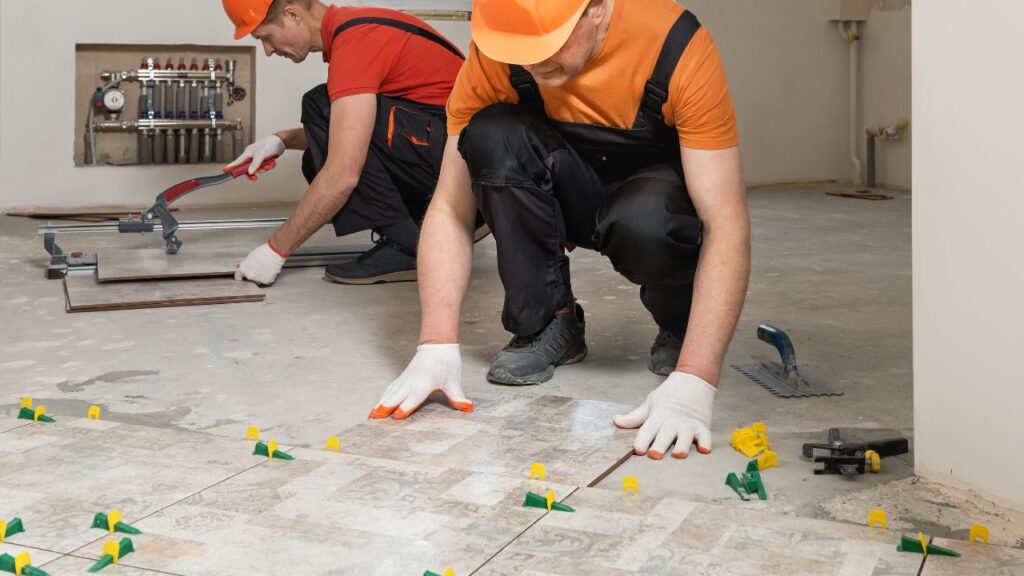Flooring Cost Estimator
Estimate Florida Consulting boasts a team of skilled estimators dedicated to delivering professional residential and commercial flooring estimating services.

To answer the burning question, “How much does it cost to refloor a house?” we need to delve into the details. The cost can vary significantly, but on average, it ranges from $1,500 to $10,000+. The national average stands at $4,000+. However, your specific project costs will depend on several factors.
Reflooring your house can be a transformative project that offers a wide range of possibilities, catering to various budgets and style preferences. To make informed decisions, it’s essential to grasp the factors that contribute to the overall cost. Here’s a detailed breakdown of the typical cost range, considering various aspects of the project:
The choice of flooring material is one of the most critical factors influencing the cost of your reflooring project. Flooring materials come in a broad spectrum of options, each with its own price range. Here’s a more comprehensive look at some common choices:

The size of the area you plan to refloor is a direct and significant determinant of the overall cost. Larger rooms or whole-house projects naturally require more materials and labor, increasing the total expenses. To get an accurate estimate, measure the square footage of the space accurately.
Labor costs are not uniform and can vary significantly depending on your location, the scope of work, and the flooring material chosen. More complex jobs, such as installing intricate patterns or working with challenging materials, tend to incur higher labor expenses. It’s essential to obtain multiple quotes from qualified flooring professionals to compare labor costs accurately.
Flooring Cost Estimator
Estimate Florida Consulting boasts a team of skilled estimators dedicated to delivering professional residential and commercial flooring estimating services.

Before installing new flooring, it’s crucial to assess the condition of the subfloor. In some cases, subfloor repairs or leveling may be necessary to ensure a smooth and durable installation. The extent of subfloor work required can add to the overall cost, as it involves additional materials and labor.
If your home has existing flooring that needs to be removed before installing the new one, this process will contribute to the project’s expenses. The removal of old flooring can be labor-intensive, especially if it’s glued down or has multiple layers.
To provide you with a more comprehensive understanding of the expenses associated with different flooring options, let’s delve deeper into the details of each flooring type:
Laminate flooring is a cost-effective choice for homeowners seeking affordability without sacrificing aesthetics. On the lower end of the spectrum, you can expect to spend as little as $1,500 for an average-sized room. This estimate includes not only the cost of the laminate material itself but also the installation charges, which can vary based on labor costs in your local area. Furthermore, you may need to consider additional features like moisture barriers or premium underlayment, which can increase the overall cost while enhancing the performance and durability of your laminate flooring.
Vinyl flooring is a versatile and budget-friendly option, suitable for both small spaces and entire houses. The average cost for vinyl flooring in a typical home ranges around $2,500. This price encompasses the vinyl material, professional installation, and any necessary underlayment or adhesive. The specific type of vinyl you choose (sheet, plank, or tile), along with its quality and design, can significantly influence the overall cost. Keep in mind that the durability and ease of maintenance of vinyl make it a cost-effective long-term investment.
Hardwood floors exude a sense of luxury and elegance that can enhance the ambiance of any space. However, they come with a higher price tag compared to laminate and vinyl options. The cost of hardwood flooring can vary significantly based on several factors, including the wood species, grade, and the complexity of the installation. On average, you can expect to spend between $3,000 and $8,000 for hardwood flooring in a standard-sized room. This estimate covers not only the hardwood material but also expenses related to subfloor preparation, professional installation, and finishing. If you opt for rare or exotic wood species, the cost tends to fall on the higher end of this range.
Tile flooring offers a wide range of design possibilities and material options, making it a popular choice for various settings. The cost of installing tile can vary widely due to factors such as the type of tile (ceramic, porcelain, natural stone), the size of the area, and the intricacy of the design or pattern. On average, homeowners can anticipate spending between $3,500 and $7,000 for tile flooring in a standard-sized space. This cost includes not only the tile material and professional labor but also expenses associated with grout, underlayment or backer board, and any custom designs or patterns you may desire. Tile’s durability and resistance to moisture make it an excellent choice for high-traffic areas.
Natural stone flooring is renowned for its timeless beauty and durability, though it does come with a substantial price tag. If you’re considering natural stone for your flooring project, you should budget between $6,000 and $12,000. This cost takes into account the purchase of the natural stone material (marble, granite, travertine, etc.), professional installation, sealing to protect against stains and damage, and any additional treatments or finishes you may want to enhance its appearance. The final expense can vary significantly based on the rarity and quality of the chosen stone, as well as the complexity of the installation design, which may involve intricate patterns or mosaics.
The installation costs of flooring materials can significantly impact your overall budget when renovating or upgrading your space. These costs encompass various aspects, including labor charges, which can vary based on several factors. Complexity plays a crucial role, as intricate patterns or designs may require more time and expertise. Additionally, the location of the installation can affect costs; for instance, installing flooring in a hard-to-reach or confined area may increase labor expenses. Furthermore, the type of flooring material you choose can influence installation costs.

Some materials, such as hardwood or natural stone, may require more intricate and time-consuming installation techniques compared to others like laminate or vinyl.
One important decision to make when considering flooring installation is whether to go the do-it-yourself (DIY) route or hire professional installers. Each option comes with its own set of advantages and drawbacks that can impact both the quality of the finished project and the overall cost.
Opting for DIY installation can potentially save you a significant amount of money on labor costs. This approach is well-suited for those who have some experience with home improvement projects and the necessary tools. It allows you to have greater control over the timeline and process.
However, it’s important to consider the following factors when choosing DIY installation:
Hiring professional installers can ensure a high-quality, flawless finish for your flooring project. These experienced individuals have the expertise and tools needed to handle various flooring materials and installation techniques efficiently.
However, it’s essential to consider the following aspects of professional installation:
When planning for a flooring project, it’s important to anticipate various additional expenses that might arise, apart from the actual cost of the flooring material itself. These additional costs can significantly impact your overall budget and should be factored in during your planning stage.
One critical aspect of any flooring installation is ensuring a level and stable subfloor. The subfloor is the foundation on which your new flooring will be laid, and any irregularities or damage in this layer can lead to problems down the line. Subfloor preparation is the process of repairing and leveling the existing subfloor to ensure a smooth and secure base for your new flooring.
The cost of subfloor preparation can vary depending on the extent of repairs needed and the type of subfloor material. On average, you can expect to pay between $1 to $2 per square foot for subfloor preparation. Factors that can influence the cost include the condition of the existing subfloor, the need for leveling compounds, and the labor required for the job. It’s essential to have a professional assess your subfloor to determine the specific requirements for your project and provide an accurate cost estimate.
Underlayment is a layer of material that is installed between the subfloor and the new flooring. Its purpose is to provide additional support, insulation, and noise reduction, depending on the type of flooring you’re installing. Underlayment is often necessary for certain flooring types, such as laminate, engineered hardwood, and vinyl, to enhance the performance and longevity of your new floor.
The cost of underlayment can vary depending on the material chosen and the specific needs of your project. Generally, underlayment prices range from $0.50 to $2 per square foot. Thicker or specialized underlayment materials may cost more, but they can offer improved sound insulation and comfort underfoot.
When deciding whether to include underlayment in your flooring project, consider factors such as the type of flooring, the condition of your subfloor, and your desired level of comfort and soundproofing. Consulting with a flooring professional can help you select the right underlayment material and determine the associated costs for your specific project.
Effective preparation is a fundamental element in achieving a successful reflooring project. Before the installation process begins, it’s essential to carefully plan and execute several key steps to ensure a smooth and trouble-free experience. First, clear the area to be refloored of all furniture, rugs, and any other objects that may obstruct the installation process. Next, inspect and address any issues with your existing subfloor, which may require repairs or leveling to provide a stable foundation for your new flooring.

Additionally, if your chosen flooring type necessitates underlayment, make sure to install it correctly to enhance performance and comfort. Lastly, coordinate with your flooring professional to establish a timeline that accommodates the necessary drying or acclimation periods for your new flooring material. By taking these proactive steps, you’ll be well-prepared for your reflooring project, ensuring a successful and satisfying outcome that enhances the beauty and functionality of your space.
After the installation of your new floors, it’s essential to establish a routine maintenance regimen to preserve their beauty and longevity. Start by regularly sweeping or vacuuming to remove dirt and debris that can scratch the surface. For hard surfaces like hardwood or laminate, damp mopping with a manufacturer-recommended cleaner will help maintain their shine without causing damage. Be cautious with excess moisture, especially for wood floors, as it can lead to warping or staining. Use felt or soft pads under furniture legs to prevent scratches, and consider area rugs or mats in high-traffic areas to reduce wear. For carpeted floors, periodic professional cleaning can extend their lifespan and keep them looking fresh. Finally, be mindful of any specific care instructions provided by your flooring manufacturer to ensure you’re using the right cleaning products and techniques. By following these maintenance tips, you can enjoy your new floors in pristine condition for years to come.
The cost to refloor a house can vary widely depending on several factors, including the type of flooring material, the size of the area to be refloored, labor costs, subfloor preparation, and the removal of existing flooring. On average, homeowners can expect to spend between $1,500 to $10,000 or more. The national average cost stands at approximately $4,000. To get an accurate estimate for your specific project, it’s recommended to consult with flooring professionals and consider the specific details of your renovation.
Several factors influence the cost of reflooring a house. These include the type of flooring material chosen (e.g., laminate, vinyl, hardwood, tile, natural stone), the size of the area to be refloored, labor costs, subfloor preparation, the removal of existing flooring, and any additional expenses like underlayment or specialized features. The overall cost will depend on a combination of these factors, and it’s essential to consider them when planning your project.
The choice of flooring material is a significant determinant of the overall cost. Different materials come with varying price ranges. For instance, laminate and vinyl flooring are often more budget-friendly, while hardwood and natural stone tend to be on the higher end of the cost spectrum. The type of material you choose will not only affect the initial cost but also long-term durability and maintenance expenses.
The decision to install flooring yourself (DIY) or hire professionals depends on your skills, time availability, and the complexity of the project. DIY installation can save on labor costs but may require a higher level of expertise and time commitment. Professionals, while more expensive upfront, can ensure high-quality installation and often provide warranties for their work. The choice should be based on your comfort level with DIY projects and the specific requirements of your flooring installation.
Yes, there are several additional expenses to consider when reflooring a house. These can include subfloor preparation to ensure a level surface, the removal of existing flooring, underlayment for certain flooring types, labor costs, and any specialized features or treatments you may want to include in your project. It’s crucial to account for these expenses in your budget to avoid surprises during the renovation process.
The cost of reflooring a house is a multifaceted matter that hinges on various factors, making it challenging to provide a one-size-fits-all answer. On average, the national cost stands at around $4,000, but this figure can fluctuate significantly based on several key considerations. Firstly, the type of flooring material you choose plays a pivotal role; laminate and vinyl are budget-friendly options, while hardwood and natural stone come at a higher cost. The size of the area to be refloored directly impacts expenses, with larger spaces necessitating more materials and labor. Labor costs themselves can vary based on complexity, location, and the chosen flooring material. Subfloor preparation and the removal of existing flooring add to the overall cost, and these are often overlooked factors that require budget allocation. Furthermore, the decision to go with DIY installation or hire professionals carries its own cost implications and quality considerations. Finally, it’s vital to factor in additional expenses like subfloor preparation and underlayment costs when planning your project. In essence, the cost to refloor a house is a dynamic and customizable figure that depends on your unique project specifications and preferences. Proper preparation, careful consideration of these factors, and diligent maintenance after installation will ensure a satisfying outcome that enhances the beauty and functionality of your living space for years to come.
Here I am going to share some steps to get your flooring cost estimate report.
You can send us your plan on info@estimatorflorida.com
Before starting your project, we send you a quote for your service. That quote will have detailed information about your project. Here you will get information about the size, difficulty, complexity and bid date when determining pricing.
We do flooring cost estimating and prepare a detailed report for your project. At last, you finalize the report and finish the project.



561-530-2845
info@estimatorflorida.com
Address
5245 Wiles Rd Apt 3-102 St. Pete Beach, FL 33073 United States
561-530-2845
info@estimatorflorida.com
Address
5245 Wiles Rd Apt 3-102 St. Pete Beach, FL 33073 United States
All copyright © Reserved | Designed By V Marketing Media | Disclaimer